Hans Frank, the infamous general governor of the occupied Polish lands, hanged on the gallows in the Nuremberg prison on October 16, 1946. However, the "king of Poland" almost ended his miserable life almost three years earlier, dying in an attack organized by soldiers of the Home Army !
It is the end of January 1944. The Germans receive a heavy spanking on the Eastern Front, and the situation on the Apennine Peninsula is not rosy. However, this is no reason not to celebrate the eleventh anniversary of Adolf Hitler's rise to power. On the territory of occupied Poland, the Nazis additionally celebrate on January 30 with the fourth anniversary of the end of the process of creating the General Government.
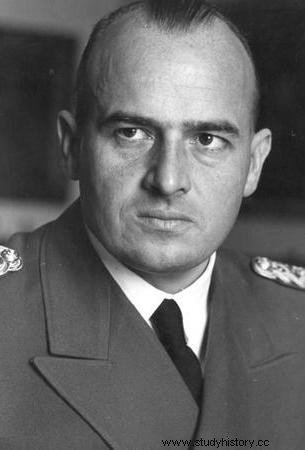
Hans Frank was hanged on the gallows on October 16, 1946, but he was close to saying goodbye to this world in January 1944.
On this occasion, Governor General Hans Frank plans to travel by train to Lviv, where the central ceremonies are to take place. The Polish underground also decides to celebrate this very sad date for us ... by sending the hated criminal to the afterlife.
Planning and preparation
The governor-general has been at the top of the list of potential targets for a long time. Until now, however, for fear of reprisals that could be caused by an action directed against him, people had limited themselves to the intensive observation of the daily schedule of the "host" of the Wawel Hill. In the end, however, the ruthless terror of the occupier and the approach of the Eastern Front emboldened the command of the Kraków District of the Home Army.
Around 20 January 1944, the commander of the same, Colonel Józef Spychalski "Luty" instructed Lieutenant Ryszard Nuszkiewicz "Slow" to prepare a plan to blow up the train on which Frank would go to Lviv. The general guidelines also spoke of setting up a fire ambush.
"Slow" immediately set to work. The first step was, of course, selecting a suitable place to plant the explosives. The choice fell on the Niepołomice Forest, and more specifically on the area between Podłęże and Grodkowice (now Szarów) stations.
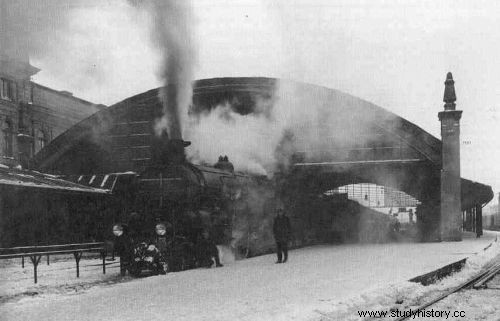
Main Railway Station in Kraków during the occupation. Here Hans Frank was to start the last journey in his life…. (photo from the album:Krakow during the occupation 1939-1945, Historical Museum of the City of Krakow, 2010).
As he recalled years later in the book "Dynamit. From the history of the Resistance Movement in Southern Poland ”R. Nuszkiewicz:
in submitted "Jarema" [Dr. Stefan Tarnawski, head of the Krakow Kedyw - editor's note of the author of the article] of the situational sketch, I propose as an ambush the area of the water reservoir located between the Cudów-Niepołomice road and the Grodkowice railway station. The small water lagoon by the railway track and the forest were an important asset for the fire-traffic ambush, while the railway track was neither better nor worse than any other section of the route.
Now that the plan was ready, it was time to assign people to implement it. It was decided that they would be partisan units called "Błyskawica" and - currently being formed - "Grom". Total 25 soldiers. There was also a miners' team of several people.
Major Stanisław Więckowski "Wasacz" was appointed the commander of the entire operation - a liaison officer of the AK District Staff in Kedywo. In addition, the men of captain Mieczysław Cieślik "Bąk" - commander of the Diversionary District in Wieliczka - dealt with the preparation of a mock jump over the Vistula.
The next phase of preparations was to "organize" the explosives, as well as to obtain a sufficient number of machine guns and grenades necessary to complete the destruction caused by blowing up the tracks. Unfortunately, there are some serious problems here.
First of all, the District was unable to deliver the plastic ordered by "Mustache", or any other strong explosives. Therefore, they had to be satisfied with powdered TNT stolen from the salt mine in Wieliczka, from which "Slow" and "Mars" (second lieutenant Zygmunt Kawecki) made a face.
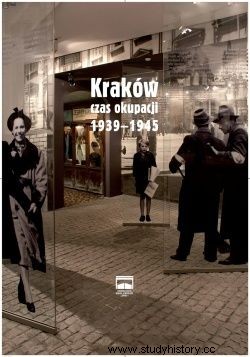
"A second too late" is another article that we publish as part of our cooperation with MHMK. It was created, inter alia, on the basis of the album "Kraków - time of occupation 1939-1945" published by this institution in 2010.
Additionally, neither three hand-held machine guns nor 100 grenades arrived, which made it impossible to carry out an effective fire ambush at the outset. As if that was not enough, major Więckowski caught a heavy flu, practically excluding him from the entire operation - his duties had to be taken over at the last minute by Lieutenant Nuszkiewicz. Despite all the obstacles, it was decided that the action would be carried out and its finalization began on January 29, around 9 p.m.
Assassination
Meanwhile, in Krakow, unaware of anything, Frank and his entourage (including SS-Obergruppenführer Wilhelm Koppe) at 10.30 p.m. they went to Hauptbanhoff (i.e. the Main Railway Station) to take their seats on the train going to Lviv. Of course, they did not travel in ordinary carriages, as they had two luxurious salons at their disposal. Frank along with his adjutant Helmuth Pfaffenroth and three other officers traveled in lounge number 1006, while Koppe and three other Nazi dignitaries traveled in room number 1001. In addition, 25 armed to the teeth officers from the German Railway Security Police Headquarters were in the third passenger car. At 10:45 PM D-Zug set off towards the main city of the Galicia District.
Attention! You are not on the first page of the article. If you want to read from the beginning click here.
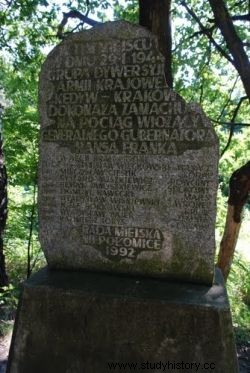
Monument commemorating the failed attempt.
At the same time, 22 kilometers away, everything was ready. The engineer patrol had already set up an explosive device and now it was only necessary to wait for the depot to arrive. It was noticed around 11:15 p.m., two minutes later the nighttime joy was torn apart by a powerful explosion, which unfortunately happened literally a fraction of a second too late. As Dieter Schenk writes in the biography of Hans Frank:
it tore out about a meter of rails from the sleepers just behind the last axis of lounge no.1006 which swayed side to side. Salon 1001 fell off the rails and swayed along the sleepers, as did the security car behind it.
The Germans were incredibly lucky because nobody was hurt - not counting a few bruises and scrapes, of course. As soon as the train stopped, the guards of the governor-general poured out from its interior, engaging in shelling the surrounding forest. On the occasion, the whole area was lit with flares. In this situation, the Home Army had no choice but to make a previously planned jump.
The bombers didn't have much trouble escaping, with one exception (they split into three groups). Well, weakened by the flu, "Mustache" (who nevertheless took part in the action) at some point was unable to go any further. Fortunately, two of his companions, "Slow" and "Spokojny" (second lieutenant Henryk Januszkiewic), came to his aid. For several kilometers they had to lead him by the arm, as he barely shuffled his feet. Luckily, they found a temporary shelter in a hospitable peasant cottage near Wieliczka, where "Mustache" regained enough strength to move on.
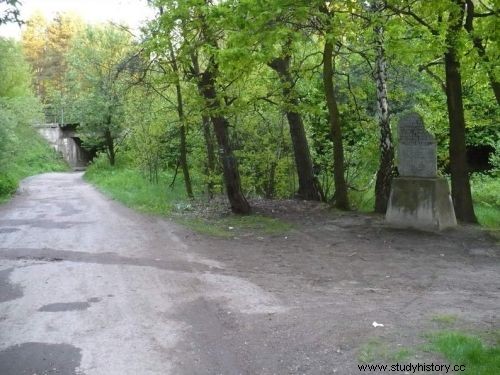
The site of the failed assassination attempt on Hans Frank. Contemporary photo.
Meanwhile, Frank returned to Krakow after a few hours with a different squad. Interestingly, the attack did not discourage him from going to Lviv. This time, however, he chose air transport, specifically the military Junkers Ju 52.
Repercussions
Of course, the occupiers could not leave this matter without taking "appropriate" consequences. Although the Home Army tried to blame the attack on the Soviet partisans by scattering Soviet leaflets they had found earlier, Koppe and his henchmen were not fooled. As he writes in one of the texts in the album of the Historical Museum of the City of Krakow, entitled "Krakow - the time of occupation 1939-45" Grzegorz Jerzozwski: In retaliation for the attack on Frank, the Germans shot 100 Poles. Mass executions were carried out in Podłęże and Dębica, and the victims were mainly prisoners from Montelupich.
We recommend:
Permanent exhibition "Cracovians against terror 1939-1945-1956" in the "Pomorska Street" branch of the Museum of the History of the City of Krakow (2 Pomorska Street, the branch is open from Tuesday to Sunday).
